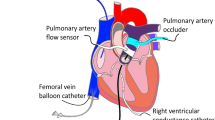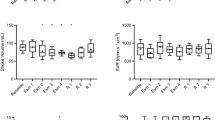Summary
The influence of changes in pre- and afterload, heart frequency and inotropic state on the difference between right ventricular dP/dt max measured isovolumically and auxotonically has been investigated in canine heart-lung preparations. Isovolumic systoles were obtained by occluding the pulmonary artery during diastole by balloon inflation. The mean difference between isovolumic and auxotonic dP/dtmmax is 40 mm Hg/sec (15 to 80 mm Hg/sec)-i.e. about 10% of the value measured auxotonically.
Neither hemodynamic (pre- and afterload changes) nor inotropic changes influence this difference. Heart rate increase from 140 to 200/min also has no effect. This corresponds with the unchanged time interval between pulmonary valve opening and right ventricular dP/dt max under all these conditions. Only heart rates below 100/min seem to enhance the difference between isovolumic and auxotonic dP/dt max.
Since the difference is not altered at various inotropic states, the result of this study leads to the conclusion that the relative changes in contractility could be slightly overestimated by using the auxotonic dP/dt max for inotropic assessment. Practically, this inexactitude iswwithin the error range of the method. Therefore, the use of dP/dt max measured auxotonically does not introduce a marked disadvantage related to isovolumic dP/dt max for assessment of relative inotropic changes of the right ventricle in isolated hearts.
Zusammenfassung
In 18 Herz-Lungen-Präparaten wurde der Einfluß von Veränderungen in der Vor- und Nachbelastung des Herzens, der Herzfrequenz sowie dem inotropen Zustand des Myokards auf die Differenz zwischen dem isovolumetrisch und auxotonisch gemessenen rechtsventrikulären dP/dt max bestimmt. Isovolumetrische Kontraktionen des rechten Ventrikels wurden durch Aufblasen eines Ballons in der Arteria pulmonalis während der Diastole erzeugt. Die mittlere Differenz zwischen dem isovolumetrisch und auxotonisch bestimmten dP/dt max betrug 40 mm Hg/s (15–80 mm Hg/s). Die Differenz stellt etwa 10% des auxoton gemessenen Wertes dar.
Diese Differenz wird weder durch hämodynamische Veränderungen (Vor-und Nachbelastung) noch durch Veränderungen des inotropen Zustandes beeinflußt. Eine Zunahme der Herzfrequenz von 140 auf 200 S/min hat ebenfalls keinen Einfluß. Dies entspricht dem Befund, daß das Zeitintervall zwischen der Öffnung der Pulmonalklappen und dem Maximum des rechtsventrikulären dP/dt unter all diesen Bedingungen unverändert bleibt. Lediglich eine Verminderung der Herzfrequenz unter 100 S/min scheint zu einer Zunahme der Differenz zwischen isovolumetrisch und auxoton bestimmtem dP/dt max zu führen.
Da sich die Differenz bei verschiedenen inotropen Zuständen nicht ändert, lassen diese Versuche den Schluß zu, daß relative Veränderungen in der Kontraktilität geringfügig überschätz werden, wenn auxoton gemessene dP/dt max-Werte für die Beurteilung herangezogen werden. Diese Ungenauigkeit liegt aber praktisch innerhalb der Fehlerbreite der Methode. Bei der Beurteilung relativer Inotropieänderungen des rechten Ventrikels isolierter Herzen bedeutet deshalb die Verwendung von auxoton gemessenen dP/dt max-Werten keinen deutlichen Nachteil gegenüber der Verwendung des isovolumetrischen dP/dt max.
Similar content being viewed by others
References
Hoppe, H., F. Schilling, H. D. Schmidt, Pflügers Arch.335, R 14 (1972).
Hoppe, H., H. D. Schmidt, Pflügers Arch.347, R 6 (1974).
Knowlton, F. P., E.HH. Starling, J. Physiol.44, 206–219 (1912).
Krayenbühl, H. P., Die Dynamik und Kontraktilität des linken Ventrikels. Bibliotheca Cardiologica, 182 S. (Basel-New York 1969).
Krayer, O., E. Schütz, Z. Biol.92, 453–461 (1932).
Morgenstern, G., G. Arnold, U. Höljes, W. Lochner, Pflügers Arch.315, 173–186 (1970).
Niehues, B., V. Schwanik, K. Hagemann, S. Manoli, S. Oswald, G. Arnold, W. Lochner, Z. Kardiol.62, 1029–1040 (1972).
Schmidt, H. D., H. Hoppe, Preload dependence of dP/dt max, V max and VCE max compared to the inotropic sensitivity of these indices of cardiac contractility. In preparation.
Schmidt, H. D., H. Hoppe, Maximal rate of pressure rise and time parameters in the right ventricle under isovolumic conditions. Investigations in the canine heart-lung preparation. Basic Res. Cardiol., in press.
Schmidt, H. D., H. Hoppe, W. Schneider, Verh. Dtsch. Ges. Kreislaufforschg.39, 151–156 (Darmstadt 1973).
Author information
Authors and Affiliations
Additional information
With 6 figures and 2 tables
Rights and permissions
About this article
Cite this article
Hoppe, H., Schmidt, H.D. & Seitz, E. The maximal rate of pressure rise in the right ventricle of isolated canine hearts in isovolumic and auxotonic systole under various hemodynamic and inotropic conditions. Basic Res Cardiol 71, 530–541 (1976). https://doi.org/10.1007/BF01909767
Received:
Issue Date:
DOI: https://doi.org/10.1007/BF01909767




